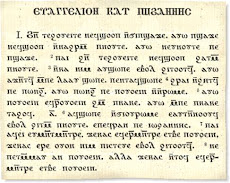The Sahidic Coptic version corroborates early Christian Christology in many of its readings. This is especially true regarding the doctrine of the Trinity, since the most that can be read from Coptic John 1:1c is that "the Word was divine," not "the Word was God." Literally, what the Coptic version says is "the Word was a god."
This is consistent with what historians know about the development of the doctrine of the Trinity. As one edition of the New Encyclopedia Britannica puts it, "Neither the word Trinity, nor the explicit doctrine as such, appears in the New Testament....The doctrine developed gradually over several centuries and through many controversies." (Micropedia, Volume X, p. 126) It was not until the 4th Christian century that the doctrine of the Trinity was firmly established in the churches.
Likewise, the book Encyclopedia of Early Christianity, edited by Everett Ferguson, says, "Primitive Christianity, like Judaism, was distinguished from paganism by its unqualified monotheism." (page 912) This "unqualified monotheism" also distinguished the Christology of primitive Christianity from later Trinitarianism.
Since the Sahidic Coptic version pre-dates the 4th century, being dated in the late 2nd or early 3rd century, it is not surprising that it does not labor under the doctrine of the Trinity. Not only does the Coptic version refrain from identifying Jesus as God Almighty at John 1:1c. It also does not contain the Trinitarian addition at 1 John 5:7 ("these three are one"), nor speak of 'the church of God which he purchased with his own blood,' (Acts 20:28) nor does it say that 'God was manifested in the flesh.' (1 Timothy 3:16) Rather, it speaks of the "church of the Lord" and says merely "this one who" was manifested in the flesh at 1 Timothy 3:16, not "God." Nor does it contain the added words at John 3:13, "[the Son of man] who is in heaven," which incorrectly indicates that Jesus could be God in heaven and Man on earth at the same time. Instead, like the earliest extant Greek manuscript of the Gospel of John, the p66 [Papyrus Bodmer II], the Sahidic Coptic text omits that unauthorized addition.
Other renderings of the Sahidic Coptic version also corroborate the fact that early Christian Christology, while an exalted Christology, was 'unqualifiedly monotheistic,' not Trinitarian. The Coptic readings are theologically neutral and frequently very literal readings of the New Testament Greek text.
Thursday, July 30, 2009
Subscribe to:
Posts (Atom)
